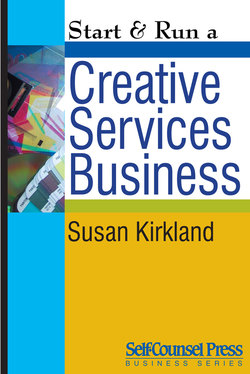Читать книгу Start & Run a Creative Services Business - Susan Kirkland - Страница 34
На сайте Литреса книга снята с продажи.
2.9 Create a business image
ОглавлениеCreating a dedicated work space includes creating a professional image. Even in today’s digital era, you will need a business card and some form of stationery, either as a workable template that you can print as needed or a professionally designed letterhead package printed by an old-fashioned letterpress printer. You will also find it useful to have a JPEG image of your business card to include with email correspondence. Remember one of the keys to creating a successful image: act as if.
If you are capable of competing with industry leaders, make sure your image shows it. Looking for serious work requires a serious image appropriate to industry expectations. If you want to be a clown, make your business card colorful and fun, with a wild and crazy typeface. Otherwise, use good sense when selecting your identity font; choose something well-proven that doesn’t shout, “I’m an amateur.”
Creative counsel requires cutting-edge imagination, yet nothing detracts more than the latest-fad fonts. If in doubt, consult a professional designer. However, don’t let all this conservatism inhibit your creativity. The creative services field allows more leeway than other business arenas when it comes to self-promotion. My advice is to rein in your wildly creative side just a tad so you don’t frighten the average businessperson. If you scare them, or suggest you are completely uncontrollable, they won’t hire you.
An important aspect frequently overlooked by the overzealous marketer is clarity: Can you read the phone number or do you need a magnifying glass and a translator to figure out what it says? Can you only read it because you know what it’s supposed to say? Your client won’t know what it says and won’t be able to reach you because of it.
Remember the purpose of your business card. It was from the lowly calling card that the business card evolved; it gives the recipient an impression, one carefully controlled by design and stock selection. (Victorian society first had social cards featuring only a name, then calling cards, then the business card evolved.) Subtle details create the desired impression, so tread carefully.
Steer clear of flashy thermography, which is a cheap substitute for engraving. Would you cover your Jaguar’s dash with pink shag carpeting? Wear climbing boots with a Yves St. Laurent strapless gown? Probably not. Thermography has the same effect for those who know the difference between true engraving and expanded plastic powder sprinkled on ink to raise the type.
Lay a good foundation when you create your work space, and both your creativity and client list will grow.
Another thing to avoid at all costs is handing out your business card for personal purposes; this will dilute its effect and render you quickly cardless. It’s bad form to hand out business cards in a bar; use your business card to get business, your personal card to get dates.
Keep in mind the code of card turning. The code was originally intended for social cards. As Judith Martin explains in Miss Manners’ Guide to Excruciatingly Correct Behavior, such cards “are hardly used now that people imagine they have better things to do with their time than to ride about in their carriages all morning, paying calls on one another. So you may amaze and delight your business acquaintances, as well as mystify them, by turning cards on them.” She continues: “There are four statements you can make just by bending your business card’s corners. They are: visité (upper left), meaning you have appeared with the card in person; félicitation (upper right), meaning that you congratulate the recipient; congé (lower left), which announces that you are leaving town; and condolence (lower right), which is, of course, an expression of sympathy. If you promise to revive this custom, Miss Manners will permit you to get funny with it by, say, turning both bottom corners for ‘Too bad, I’m leaving you’ or both right corners for ‘Congratulations on your loss.’”[1]
Let’s dig up a truly overused cliché: You reap what you sow. Starting a business is like starting a garden. Setting up your work environment is like using a plow and fertilizer to condition the soil. Seed (cover the town with promotional material), feed (reconfirm and recontact until you become a familiar face), and weed it (head off the competition) until your garden is lush and reaps a bounty of rewards. Leave it untended, ignore your clients, and pretty soon some nasty weeds will take over. Lay a good foundation when you create your work space, and both your creativity and client list will grow.
